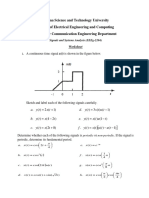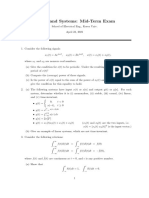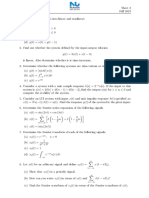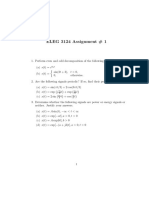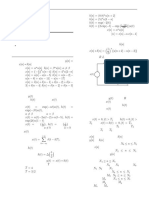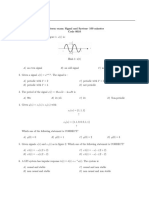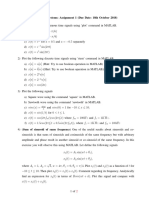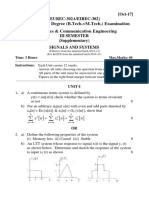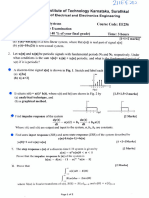Worksheet I
Worksheet I
Uploaded by
Alemayew AzezewCopyright:
Available Formats
Worksheet I
Worksheet I
Uploaded by
Alemayew AzezewOriginal Description:
Original Title
Copyright
Available Formats
Share this document
Did you find this document useful?
Is this content inappropriate?
Copyright:
Available Formats
Worksheet I
Worksheet I
Uploaded by
Alemayew AzezewCopyright:
Available Formats
Addis Ababa Science and Technology University
College of Electrical and Mechanical Engineering
Electrical and Computer Engineering Department
Signals and Systems Analysis (EEEg-3105)
Worksheet-I
1. Describe the following concepts using examples in relation to signals and systems
analysis.
a. Signals
b. Systems
2. A continuous-time signal x(t) is shown in the figure below.
Sketch and label each of the following signals carefully.
November 2023 Page 1
a. y(t)=2x(t+1) d . y(t)=3 x(t)u(t−1)
b. y(t)=x(4−2t) e. y(t)=x(t)u(1−t)
c . y(t)=x(2t+8) f . y(t)=x(t) [ u(t)−u(t−1)]
3. Consider the two discrete-time signals given by:
x 1 (n)=|n|[ u(n+4)−u( n−4)]
and
x 2 (n)=n [ u(n+5)−u(n−5) ]
Sketch and label each of the following signals derived from x1(n) and x2(n)
carefully.
November 2023 Page 2
a. y(n)=x 1(n) e . y(n)=x2 (3n)
b. y(n)=x 2 (n) f . y(n)=x 1
n
2 ()
c . y(n)=x 1(3−n) g. y(n)=x 1(2n)+x 2 (3n)
d . y(n)=x 1(2n) h. y( n)=x 1 (2n)x 2 (−n)
4. Determine whether each of the following signals is periodic or non-periodic. If the
signal is periodic, determine its fundamental period.
a. x(t )=cos 2t+( ) π
4
e. x(t )=e jπt
b. x(t )=cos 2 ( t ) f . x(n)=cos n
1
4 ( )
c . x(t )=cos ( 2πt ) u(t ) g. x( n)=cos2 n
8( )
π
d . x(t )=cos(t )+sin( √ 2t )
n
h. x(n)=cos cos
2 () ( )
πn
4
5. Determine whether the following signals are energy signals, power signals or
neither.
November 2023 Page 3
a. x(t)=e−at u(t), a>0 d . x(n)=(−0.5 )n u(n)
b. x(t)=Acos ( ω0 t+φ ) e . x(n)=u(n)
j(3n)
c . x(t)=tu(t) f . x(n)=2e
6. Find the even and odd parts of the continuous-time signal given by x (t )=e2 t u ( t ) .
7. In this problem, we explore what happens when a unit impulse is applied to a
differentiator. Consider a triangular pulse x(t) of duration T and amplitude 1/2 T, as
depicted in Fig. below. The area under the pulse is unity. Hence as the duration T
approaches zero, the triangular pulse approaches a unit impulse.
(a) Suppose the triangular pulse x(t) is applied to a differentiator. Determine the
output y(t) of the differentiator.
(b) What happens to the differentiator output y(t) as T approaches zero? Use the
definition of a unit impulse δ(t) to express your answer.
x(t)
o t
8. Determine whether the systems described by the following input-output relationship
are linear, time-invariant, causal, BIBO stable, memoryless, invertible or not.
November 2023 Page 4
n+1
a. y(t)=cos[x(t)] d. y(n)= ∑ x(k)
k=−∞
b. y(t)=x(−t+2) e . y(n)=x(n)u(n)
c . y(t)=|x(2t)| f . x(n)=x(n)+nx(n+1)
9. Consider the capacitor circuit shown in Fig below. Let input x(t) = i(t) and output
y(t) = Vc(t). (a) Find the input-output relationship. (b) Determine whether the
system is (i) memoryless, (ii) causal, (iii) linear, (iv) time invariant, or (v) stable
10. A system H has its input - output pairs given. When the inputs to the systems are
x 1 ( t ) , x 2 ( t ) , ¿ x3 (t), the outputs of the system are y 1 ( t ) , y 2 ( t ) ,∧ y 3 (t) as shown. Determine
whether the system could be memoryless, causal, linear and time invariant for a signals
November 2023 Page 5
depicted in figure below. For all cases, justify your answers. Find the output due to the
input depicted in fig (b)
Assignment Questions: 1b, 1e, 2c, 2g, 3b, 3f, 3g, 5,6, 7a, 7d,8,9
November 2023 Page 6
You might also like
- Tutorial 2 - Systems (Exercises)Document3 pagesTutorial 2 - Systems (Exercises)LEIDYDANNYTSNo ratings yet
- Worksheet I 2022Document3 pagesWorksheet I 2022Wami MahammadNo ratings yet
- EC-203: Signals & SystemsDocument2 pagesEC-203: Signals & SystemsAnkita SharmaNo ratings yet
- sns 2021 중간 (온라인)Document2 pagessns 2021 중간 (온라인)juyeons0204No ratings yet
- Sheet 2Document1 pageSheet 2ahmedmohamedn92No ratings yet
- Assignment 1Document7 pagesAssignment 1Umesh KumarNo ratings yet
- EC-202 Assignment # 1Document4 pagesEC-202 Assignment # 1Sahil SinghNo ratings yet
- ELEG 3124 Assignment # 1Document16 pagesELEG 3124 Assignment # 1Nguyễn Văn ĐứcNo ratings yet
- 106_mte_2024Document2 pages106_mte_2024prsaryanjainNo ratings yet
- Haramaya Inistitute of Technology School of Electrical and Computer Engineering Signal and Systems Analysis WorksheetDocument5 pagesHaramaya Inistitute of Technology School of Electrical and Computer Engineering Signal and Systems Analysis Worksheetktesfaneh01No ratings yet
- Tutorial 1Document2 pagesTutorial 1advaitsawant2005No ratings yet
- Tutorial 2-2Document2 pagesTutorial 2-2rb6h58qcz5No ratings yet
- ps#2_2016Document2 pagesps#2_2016HArshNo ratings yet
- DSA Assignment 2Document3 pagesDSA Assignment 2Kadali Lakshmi NirmalaNo ratings yet
- Tutorial 1 Questions-1Document2 pagesTutorial 1 Questions-1Jauvenel JauviNo ratings yet
- Tutorial 1Document2 pagesTutorial 1Raj GuptaNo ratings yet
- SSHW03Document10 pagesSSHW03蘇柏No ratings yet
- Tutorial 1Document3 pagesTutorial 1Sathwik MethariNo ratings yet
- EE322M Assignment 01Document4 pagesEE322M Assignment 01shubhamNo ratings yet
- 1694843396732_20EEIC214_941_19EECC202_926_23KLE572_SSDocument2 pages1694843396732_20EEIC214_941_19EECC202_926_23KLE572_SSbalikaiabhishek70No ratings yet
- Assignment-1Document3 pagesAssignment-1Prashanna YadavNo ratings yet
- SIGNAL & SYSTEMS (BTEC-T-PC-007) - Mid Term Exam - 2021-2022Document2 pagesSIGNAL & SYSTEMS (BTEC-T-PC-007) - Mid Term Exam - 2021-2022yiyoc24420No ratings yet
- ps#1_2016Document2 pagesps#1_2016HArshNo ratings yet
- Tutorial 1Document3 pagesTutorial 1Ashish KatochNo ratings yet
- sns 2022 중간Document2 pagessns 2022 중간juyeons0204No ratings yet
- Assignment 7Document1 pageAssignment 7Việt Anh ĐinhNo ratings yet
- Midterm Exam: Signal and System-100 Minutes Code 0010Document16 pagesMidterm Exam: Signal and System-100 Minutes Code 0010HongThinh NguyenNo ratings yet
- Signal System AssignmentDocument5 pagesSignal System Assignment21ELB370MOHAMMAD AREEB HASAN KHANNo ratings yet
- 15EECC204: and Any ONE Full Question From UNIT-IIIDocument6 pages15EECC204: and Any ONE Full Question From UNIT-IIIAkshay ArksaliNo ratings yet
- Assignment 1Document2 pagesAssignment 1Harry WillsmithNo ratings yet
- Tutorial 3Document2 pagesTutorial 3factline123No ratings yet
- ps#4_2016Document3 pagesps#4_2016HArshNo ratings yet
- EE331 Chapter1 HWDocument8 pagesEE331 Chapter1 HWogkrdmn58No ratings yet
- Ese562 Lect01Document35 pagesEse562 Lect01ashralph7No ratings yet
- N N N N Y: Signals & Systems Questions Set 01Document13 pagesN N N N Y: Signals & Systems Questions Set 01Sachin Singh NegiNo ratings yet
- Assignment 2Document3 pagesAssignment 2Laith Al-KinaniNo ratings yet
- Signals and Systems-REVISION MCQDocument47 pagesSignals and Systems-REVISION MCQrajalakshmi boopathi100% (1)
- Tut 0 (Review) Signals and SystemsDocument1 pageTut 0 (Review) Signals and SystemsNasar KhanNo ratings yet
- Information and Communication Assignment 1Document3 pagesInformation and Communication Assignment 1achutunisrNo ratings yet
- Integrated Dual Degree (B.Tech.+M.Tech.) Examination Electronics & Communication EngineeringDocument4 pagesIntegrated Dual Degree (B.Tech.+M.Tech.) Examination Electronics & Communication EngineeringNaresh KumarNo ratings yet
- Question Bank EE V S&SDocument10 pagesQuestion Bank EE V S&SAbhNo ratings yet
- HW1(1)Document3 pagesHW1(1)wuyucheng0715No ratings yet
- Signal and Systems Analysis Worksheet 2: 1. Obtain The Fourier Series Expansion For Signal Shown in Figures BelowDocument7 pagesSignal and Systems Analysis Worksheet 2: 1. Obtain The Fourier Series Expansion For Signal Shown in Figures Belowewnetu kassaNo ratings yet
- ECC106_QUIZ1_2024Document2 pagesECC106_QUIZ1_2024prsaryanjainNo ratings yet
- HT TP: //qpa Pe R.W But .Ac .In: 2011 Signals and SystemDocument7 pagesHT TP: //qpa Pe R.W But .Ac .In: 2011 Signals and SystemSoumitra BhowmickNo ratings yet
- DSP_Assignment-1Document2 pagesDSP_Assignment-1sai23282018No ratings yet
- Ma Kai-Kuang (Tutorial+Lectures)Document157 pagesMa Kai-Kuang (Tutorial+Lectures)Ang KhengNo ratings yet
- Signal&systemDocument2 pagesSignal&systemJariey SallehNo ratings yet
- Sheet 1 SignalDocument5 pagesSheet 1 Signalmariamelshahawyy1No ratings yet
- EE256 - EndSemsDocument2 pagesEE256 - EndSemsSumukh KiniNo ratings yet
- (WWW - Entrance-Exam - Net) - IETE AMIETE ET-CS-IT (Old Scheme) Signals and Systems Sample Paper 1Document4 pages(WWW - Entrance-Exam - Net) - IETE AMIETE ET-CS-IT (Old Scheme) Signals and Systems Sample Paper 1Jonas ParreñoNo ratings yet
- f18 Practice Midterm1 SolutionsDocument21 pagesf18 Practice Midterm1 SolutionsAlgerian AissaouiNo ratings yet
- HW Rest Part1Document5 pagesHW Rest Part1Anand SridharanNo ratings yet
- Exercises For Signals and Systems (Part Four)Document3 pagesExercises For Signals and Systems (Part Four)Vincent YuchiNo ratings yet
- EE256 - MidSemsDocument2 pagesEE256 - MidSemsSumukh KiniNo ratings yet
- EEB731 Signals and Systems: Tutorial 2 Q1Document2 pagesEEB731 Signals and Systems: Tutorial 2 Q1Prince RaynalNo ratings yet
- 2324 HK1 HW 5Document4 pages2324 HK1 HW 5420h0317No ratings yet
- HW1 SolutionDocument3 pagesHW1 Solution박천우No ratings yet
- ELEC221 HW04 Winter2023-1Document16 pagesELEC221 HW04 Winter2023-1Isha ShuklaNo ratings yet
- Lab - 2 - BJT Char & DC BiasingDocument5 pagesLab - 2 - BJT Char & DC BiasingAlemayew AzezewNo ratings yet
- Foreign Policy of Ethiopia During DergDocument4 pagesForeign Policy of Ethiopia During DergAlemayew Azezew100% (5)
- Num 1Document2 pagesNum 1Alemayew AzezewNo ratings yet
- Problem Solving IChapter 5Document23 pagesProblem Solving IChapter 5Alemayew AzezewNo ratings yet

